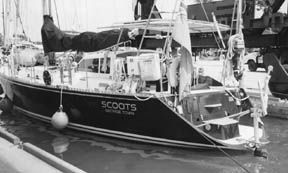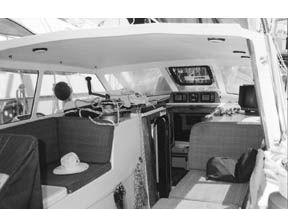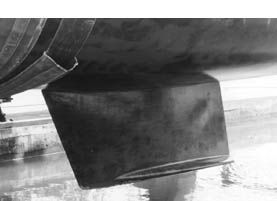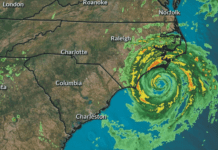Every now and then, you run into a cruising boat that seems exceptionally well-suited to the job. Skip and Ilze Sims’ Apogee 50 Scoots is such a boat. We finally caught up with Scoots in Phuket, Thailand.

We have had a longstanding passion for Chuck Paine’s fast offshore cruisers. In Sims, Paine found an experienced offshore sailor with a suitable budget to carry the Apogee concept to fruition. The result is a low-key, practical cruising boat packed with imaginative features, innovative design, and quality construction.
Launched in 1994, Scoots was the second in the Apogee 50 series built by Able Marine. Her principal dimensions are: Length 51.0′ (including sugar scoop stern), LWL 45.8′, beam 14.0′, draft 6.0′. As with every cruising boat we have encountered, she is considerably over her designed displacement and draft in cruising trim, but a powerful sailplan still qualifies her as a performance cruiser.
In common with his other designs of medium displacement, modern performance cruisers (as distinguished from his more traditional designs) Chuck Paine drew a boat with a fairly straight sheerline and the maximum waterline length you can get without having a boat that looks like the ends have been chopped off. With her nearly flush decks and low-slung pilothouse, the Apogee 50 is uncluttered and modern in appearance, but Paine’s brilliant eye for the look of a boat has created a design that even an ultra-traditionalist can appreciate. This is a boat that looks good from any angle.
But it’s not just the look of the boat, or her basic design, or her sound construction that makes this boat stand out. She is loaded with thoughtful features that showcase the collective experience of her designer, owner, and builder. Here are just a few of them.
Low Exterior Maintenance
The only exterior wood on the boat is in the cockpit. Teak cockpit coamings and cockpit sole were installed over the owner’s objections, since the boat was to be on display at boat shows. The varnished coamings are fitted with semi-permanent canvas covers. There is no wooden toerail, and even the on-deck grabrails are stainless steel.
When you get into port, a simple washdown with soap and fresh water keeps the boat looking good.
Sheltered Watchkeeping
One of the best features of the boat is its sheltered cockpit. The shelter (“doghouse” is probably the proper term) is more a very large hard dodger than a true pilothouse, since its aft end is open to the weather. But it provides excellent shelter at sea, with two seats out of the weather, a space for charts, the radar, and the primary displays for the B&G Hydra performance instrumentation.
The lowered cockpit sole in this part of the cockpit keeps the deck profile unobtrusively low while giving standing headroom under the pilothouse. The tradeoff is that the lower companionway dropboards need to be kept in place in heavy weather to block the companionway up to the main deck level.
A multi-function electric winch on the port side of the cockpit shelter eases handling of the big, full-batten mainsail. Control line tails stow neatly in shallow bins next to the winch. After several iterations, the openings in the forward end of the shelter are just large enough to pass the control lines, minimizing the amount of water that can pass through in heavy weather.
Pilothouses are notorious for becoming stiflingly hot in the tropics. Scoots has a centerline opening hatch in the front of the doghouse for fair-weather and in-port ventilation.
A final feature of the pilothouse area is a heavy stainless steel wire stretched between two big padeyes mounted on the side of the cockpit footwell. This allows you to clip on a safety harness before coming on deck, and provides a perfect place to stow harness tethers when you go off watch, avoiding dings in the cabin sole from heavy snaphooks.
Sugar Scoop Stern
Although scoop sterns are fairly common on modern boats, this one has a number of good features you rarely see.
The lower step up to the deck from inside the scoop is actually a ventilated fiberglass box that holds a 6-gallon gasoline tank for an outboard motor. Gas tanks are notoriously difficult to store, and most boats carry them on deck, where they are both unsightly and potentially dangerous.
The second step up to the deck is mounted on a large hinged fiberglass hatch lid that forms part of the transom and the afterdeck. Pull two fastpins on the lower edge of the hatch, and it pivots up to expose the liferaft for launching. You don’t have to lift the raft over the lifelines, and it is perfectly sheltered from the elements.
The third unusual feature of this scoop is a pair of massive Harken padeyes mounted in the inside corners of the transom. These are used to attach a drogue in survival conditions, should it become necessary to slow the boat down when running before a huge following sea.
Integrated Radar Arch and Bimini
Although these look like part of the original design, they are later additions.
The arch is tall, but it blends in so well with the design of the boat that you don’t even notice it ‘s there. The big open scanner for the Furuno radar is mounted on centerline. Horizontal radar beam width, which determines how well targets that are close to each other can be resolved, is a function of scanner diameter. On most sailboats, a smaller closed array is necessary to avoid fouling sails or lines.
Aboard Scoots, the radar scanner is well clear of any potential entanglement, allowing a bigger, more efficient radar system.
The ship’s other communications and navigation antennas are arrayed on either side of the radar. The normal complement of radio, GPS, and Inmarsat-C antennas is about to make room for a new direct-download satellite weather system antenna from Xaxero, best known as manufacturers of the most popular weatherfax hardware/software system for cruising boats. The new Sky Eye is a product that we’ll take a close look at in the future.
Scoots has a permanent Bimini protecting the aft half of the cockpit. It has a rigid stainless steel frame. A large array of solar panels mounted atop the Bimini helps keep the batteries fully charged. This Bimini is a sturdy, attractive solution to the problem of providing shade in the cockpit and a protected, unobtrusive location for big solar panels.
Water Ballast
Fully crewed racing boats have the advantage of being able to put a lot of meat on the rail for added stability in strong winds. Most shorthanded cruisers lack the ability to increase stability.

On Scoots, two freshwater tanks are built as ballast tanks, high under the deck and well outboard. On a heavy reach or beat, 200 gallons of water can be pumped into the windward tank, giving the weight equivalent of a half dozen beefy sailors to windward. In very light conditions, water can be pumped to leeward to increase heel and stabilize the sailplan.
Most people would be reluctant to give up the storage space sacrificed for the water ballast tanks. The Apogee 50 is big enough that the loss of storage is not a significant issue.
Watertight Bulkheads
Collisions with floating objects are no joke. Between Malaysia and Thailand, we passed within a boat length of several huge logs and trees that might well have caused major damage to our hull.
A watertight bulkhead forward in Scoots should isolate collision damage. The bulkhead separates the forward storage “garage” from the owner’s stateroom. The garage houses spare sails, a spare dinghy, spare lines, and the anchor chains, and provides the storage space for bulky items that might otherwise clutter up the decks.
Aft, the engine and machinery space is separated from the main living area by another watertight bulkhead, which features a beautiful custom watertight door for access. A feature of the engine room is a workbench equipped with a compact drill press—an incredibly useful tool to have aboard.
Triple Furling Headsails
Skip doesn’t like sailing with partially reefed headsails, so Scoots is equipped with three Furlex headsail furlers. Headsails are either fully deployed, or furled.
The inner furler holds a conventional heavy staysail. The outermost furler is usually fitted with a high-cut Yankee jib topsail, allowing the boat to be sailed as a true cutter. A #3 jib—a powerful sail for upwind sailing in heavy air, particularly when coupled with water ballast—is housed on the inner masthead furler.
For downwind sailing, the two masthead headsails can be sheeted to spinnaker poles on opposite sides of the boat. This classic downwind rig pulls the boat as if she were on rails, with the autopilot doing little work.
Although this configuration gives almost unlimited headsail combinations, it has a couple of shortcomings. When using the headsail on the outer furler, the sail must be rolled up most of the way for tacking, as there is a narrow slot between the two masthead stays.
With two masthead stays, it is impossible to get adequate headstay tension for heavy-air upwind sailing, because each stay carries roughly half the load. The answer would be a mechanism allowing you to slightly de-tension the stay not being used.
Line Deflector, Line Cutter
Boats with fin keels, exposed prop installations and spade rudders have a real propensity for grabbing fishnets and other lines at awkward times. Scoots has a small fin-shaped stainless steel line deflector mounted on the centerline of the hull just forward of the gap between the rudder and hull. This only needs to be a couple of inches deep to be effective.
In addition, a set of Spurs line cutters is mounted on the prop shaft just ahead of the three-bladed Max-Prop feathering propeller.
We have talked to numerous boat crews in Southeast Asia that have sustained a surprising amount of damage from catching fishing lines and other debris around shafts and rudders, and we would not consider a spade rudder and exposed prop installation without both of these features.
Scanning Sonar
The hottest new item of electronics for cruising sailboats is the forward-scanning and side-scanning sonar. Rather than simply giving you the depth under the boat, scanning sonars give you the far-more-useful bottom profile ahead of you. This is particularly handy in probing for anchorages and passes through coral reefs.

We recently had our first experience with scanning sonar aboard the Farr 72 Starr Trail during a race in the Phuket King’s Cup. We were hard on the wind for the finish line just past a small rocky island with a steep-to shoreline. But how steep-to was the shoreline? We would lose the three boats just to weather of us if we were forced to tack, but we had to clip this island with only inches to spare. Captain Blair Simmons turned on the forward scanning sonar, and we determined that just a few feet off the last exposed rock, the water was more than 30′ deep.
We passed within 3′ of that rock at 7 knots—something we would never have dared to do without the sonar profiling the bottom ahead and to the side.
You’re going to see a lot more of these on cruising boats in the next few years.
At this time, Interphase dominates the recreational sonar market, with a number of models with different capabilities across a broad price spectrum.
The downside is a relatively bulky transponder that could be vulnerable to damage in a collision with heavy debris.
Charging Motor
Most 50-footers have a diesel-powered generator for charging batteries and powering other AC loads. The only AC loads on Scoots are a microwave oven and various low-powered gear such as computers and chargers for cordless tools.
Instead of a big generator, she has a small Kubota diesel that drives a big 200-amp 12-volt alternator. The diesel is also directly coupled to the watermaker high-pressure pump. A couple of hours of operation a day keeps the 1,000 amp-hours of batteries charged and the water tanks full.
The nice thing about this installation is that the diesel can be sized precisely for the loads, so that it operates in its most efficient power range both for longevity and efficient fuel use. The big main engine is only used for propulsion, and is never run in a lightly loaded mode, which reduces engine life.
Shoal Draft
Thanks to her winged keel, Scoots has a designed draft of only 6′. Even heavily loaded, she still draws less than 6 1/2’—shoal draft for a 50-footer. Shoal draft may be an overrated feature for cruising, but there are times when it is extremely useful.
Conclusion
Scoots was designed and built specifically for singlehanded sailing, but the same features that make her a great singlehander make her equally suited for Skip and Ilze’s current doublehanded circumnavigation. The Apogee 50 would make a superb cruising boat for anyone looking for speed, comfort, and safety in a boat this size.
Based on our experience, a properly designed 50-footer, set up with modern sail handling equipment, is certainly a reasonably sized boat for a cruising couple to handle. A boat this size and type gives you the speed to make fast, safe passages, the living space that makes life afloat comfortable, and the storage capacity for the astonishing amount of gear and supplies that inevitably fill the long-range cruiser.
The key is not to try to cram a lot of cabins and berths into the boat. Scoots has only two sleeping cabins: a big owner’s cabin forward for use in port, and a smaller quarter cabin for use at sea. She has only a single large head, located aft near the companionway. Her interior spaces are big and open, giving the feel of an even larger boat.
The bad news is that a boat of this type is a major investment, beyond the means of most cruisers. Quality and size don’t come cheap.
The good news is that the tooling for the Apogee 50 is now owned by Morris Yachts. An Apogee 50 built by Morris, one of America’s best semi-custom builders, will be a spectacular boat indeed. Just don’t forget to bring your checkbook.
Contacts- Morris Yachts, 4 Ships Lane, Southwest Harbor, ME 04679; 207/244-5509, fax: 207/244-5866.
Also With This Article
Click here to view “Log of Calypso: Asia to Arabia.”




































